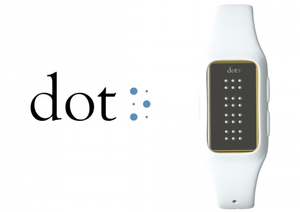Immer Mittwochs erscheint auf neunetz.com eine kommentierte Übersicht zu den wichtigsten Entwicklungen und besten Analysen aus der Welt der vernetzten Geräte, dem 'Internet der Dinge'. Vernetzte Welt kann per Email und per RSS-Feed abonniert werden.
Erste Braille-Smartwatch der Welt kommt aus Süd-Korea

Sehr super.
Dot Inc., the South Korean tech developer of the braille smartwatch, said the latest device has 30 braille dots on the face of the watch. They will be used by blind people to guide them in typing and sending messages without any form of limitation. A special module set has reduced the watch to a wearable size, making it more affordable at a selling price of $300 .
Die Macher der Smartwatch im Interview auf Tech in Asia:
Though the smartwatch will go on sale in the US and Canada first, Dot is trying out other applications for its active Braille modules in South Korea. In a push that Kim is calling “public Braille,” the company has installed modules at ATMs and in train stations. Like the smartwatch, these modules can be programmed to display information updated in real time, such as account balance information or a subway schedule.
“The Braille at ATMs currently tells you, ‘This is an ATM,’ which isn’t super helpful,” says Kim. “I think these sorts of public places, and the public sector in particular, could become our largest market in the future.”

Apple vs. FBI würde bei einer Niederlage von Apple das (US-)Internet der Dinge töten
Farhad Manjoo in der New York Times über die weitreichenden Ausmaße von "Apple vs. FBI":
Amazon, which declined to comment on how the Apple case might affect Echo users’ privacy, has said it is not constantly recording people’s voices, and that it keeps voice recordings only to help the system learn to better understand you.
But the Apple case threatens to undermine those promises. If a court can get Apple to hack into an iPhone, why couldn’t it also force Amazon to change the Echo’s security model so the Echo can record everything you say? Mr. Soghoian believes the Apple case could set that precedent.
“What we really need for the Internet of Things to not turn into the Internet of Surveillance is a clear ruling that says that the companies we’re inviting into our homes and bedrooms cannot be conscripted to turn their products into roving bugs for the F.B.I.,” he said.
Blendwerk "Industrie 4.0"
Deutschland spielt bei diesem Paradigmenwechsel auf der Anbieterseite eine Nebenrolle. Inflationäres 4.0-Begriffsgeklingel und Konferenz-Gerede können nicht darüber hinwegtäuschen, dass wir kaum Unternehmen wahrnehmen, die international in der ersten Liga der Netzökonomie spielen. Deutschland braucht eine Digitalisierungsstrategie, die über die Förderung der produktionsbezogenen Industrie 4.0 hinausgeht und die öffentliche Verwaltung ebenso einschließt wie das Gesundheitswesen, die Bildung und die private Nutzung des Internets der Dinge. So das Credo des “Jahresgutachtens der Expertenkommission Forschung und Innovation”, das ihr Vorsitzender Dietmar Harhoff vom Münchener Max-Planck-Institut für Innovation und Wettbewerb der Regierungschefin Angela Merkel überreicht hat. Die starke Fokussierung der Bundesregierung auf einen relativ kleinen Bereich der Digitalisierung sei nicht zielführend. So werde mit Industrie 4.0 einseitig auf Effizienzsteigerungen bei der Produktionstechnik abgehoben.
"Wearables Drive The Component Technology Innovation"
For years, many of the key components of wearables have been drafting off the strengths of the smartphone supply chain. During the last two years, the application processors and sensors for wrist and head-worn wearable products have more or less been taken off the parts bin of low and mid-tier smartphones. (...)
In 2016 we are seeing the tide turn. Manufacturers across the entire mobile industry supply chain are introducing new products directly targeted for wearables. Processors are getting smaller and more power efficient and performance is tuned for the unique needs of the category. The entire industry of flexible electronics, batteries and displays are being driven largely by the needs of the next-generation wearables.
Bezahlsysteme im Smart Home
TechCrunch über Payments im Smart Home:
Several smart devices displayed at the recent CES show in Las Vegas feature the ability to replenish and pay for supplies automatically. For example, Samsung’s Family Hub refrigerator features an LCD screen that doubles as a communication center that can connect to Bluetooth wireless speakers. Three interior cameras capture images every time the fridge door closes, thereby enabling it to take stock of its contents and transmit them to the user’s smartphone.
Consumers can select their needed items from various online grocer and key integration partners. The final shopping list is secured with a four-digit pin. Items are then paid for in a simple, single checkout experience that accepts U.S.-issued credit and debit cards.
Amazon Dash embedding enables Whirlpool’s 2016 line-up of dishwashers, dryers and washers to order necessary supplies when you are running low. Amazon Dash buttons connect users with specific brands.
Und die sich daraus ergebenden Fragen:
What could go wrong, you ask? As it happens, quite a lot.
For one thing, many of today’s smart appliances (like the Samsung refrigerator and the Whirlpool dishwasher) only enable consumers to hook up with certain suppliers, limiting you to their products, payment methods and price ranges. By hooking up automatically, you are actually depriving yourself of the option to search for timely special offers or use different payment options.
Another problem is that many of these smart systems rely on Internet connection, Wi-Fi or Bluetooth to place and pay for orders. Several questions arise, like what happens if the Internet is down, your Wi-Fi is iffy or your Bluetooth isn’t working?
Wie JavaScript das Internet der Dinge eroberte
ARC:
The reason that JavaScript works for the Web is the same reason that it works on the server and will eventually work for the Internet of Things: its prime feature allows for parallel programming, letting certain features run while not inhibiting others. On the server, Node.js is event-driven, which makes it perfect for running fairly simple devices that send data to a Web client and a server. (...)
A growing variety of projects have cropped up over the last several years to combine JavaScript and Node.js to the Internet of Things. Node-RED is a visual tool for wiring the Internet of Things built by members of the IBM Technology Services team. The Things System is a system of components and protocols running Node.js. Noduino is a JavaScript and Node.js framework for Arduino controls that also uses HTML5 Web applications and Socket.io. DeviceJS from WigWag is built on top of Google’s V8 JavaScript engine with a real-time JSOn database. Cylon.js is built to control robots and things with JavaScript. The list goes on and on.
Dass Node.js beliebt ist im Internet der Dinge ist nicht neu. Ob man es mag oder nicht, das Momentum ist da.
Mobilfunkanbieter wollen ein Stück vom IoT-Kuchen
AT&T and Verizon Wireless are not planning to let the end of 2G be the end of their IoT businesses. The carriers are investing in new technologies for IoT and leveraging existing partnerships.
Verizon’s IoT and telematics revenue grew 18% last year to $690 million. The company has certified low-power LTE chips made by Sequans for IoT use cases, but Verizon knows not all IoT connections will use LTE. The carrier is working to develop a proprietary IoT core network in partnership with Nokia Networks and Ericsson.
In addition, Verizon plans to open its ThingSpace platform to third-party network and technology service providers. ThingSpace is software designed to help developers create IoT applications, and Verizon said this week that 4,000 developers have started using the platform since it was launched last October.
AT&T is also looking beyond the cellular network when it comes to IoT, but at the same time the carrier is investing in LTE for machine connections.
Dazu passend The Times of India:
Swedish communication technology giant Ericsson, French telecommunications company Orange and US technology giant Intel have successfully conducted the world's first extended coverage trial for Internet of Things (IoT) using EC-GSM-IoT (Extended Coverage-GSM-IoT) technology in Paris.
Ein Gegenentwurf dazu ist das französische M2M-Funknetzwerk Sigfox. (Siehe Vernetzte Welt #1, und Vernetzte Welt #16 zum Samsung-Investment)
Ein anderer Gegenentwurf hält die Vernetzung lokal.
Smart Home ist noch ziemlich dumm
The extent to which IoT devices can be programmed is also an issue. For example, I'd hoped to be able to tie the motion sensor on my Nest thermostat into my Scout Alarm system. But Nest hasn't exposed enough device capabilities to make that easily doable. It's surprisingly hard to color outside the limited lines provided by IoT device makers. And that's really where the value of IoT lies. A home isn't smart if it can't respond to complex events and conditions.

